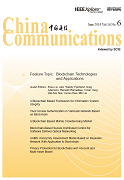NETWORKS & SECURITY
Longmei Nan, Xuan Yang, Xiaoyang Zeng, Wei Li, Yiran Du, Zibin Dai, Lin Chen
2019, 16(6): 185-199.
As an important branch of information security algorithms, the efficient and flexible implementation of stream ciphers is vital. Existing implementation methods, such as FPGA, GPP and ASIC, provide a good support, but they could not achieve a better tradeoff between high speed processing and high flexibility. ASIC has fast processing speed, but its flexibility is poor, GPP has high flexibility, but the processing speed is slow, FPGA has high flexibility and processing speed, but the resource utilization is very low. This paper studies a stream cryptographic processor which can efficiently and flexibly implement a variety of stream cipher algorithms. By analyzing the structure model, processing characteristics and storage characteristics of stream ciphers, a reconfigurable stream cryptographic processor with special instructions based on VLIW is presented, which has separate/cluster storage structure and is oriented to stream cipher operations. The proposed instruction structure can effectively support stream cipher processing with multiple data bit widths, parallelism among stream cipher processing with different data bit widths, and parallelism among branch control and stream cipher processing with high instruction level parallelism; the designed separate/clustered special bit registers and general register heaps, key register heaps can satisfy cryptographic requirements. So the proposed processor not only flexibly accomplishes the combination of multiple basic stream cipher operations to finish stream cipher algorithms. It has been implemented with 0.18µm CMOS technology, the test results show that the frequency can reach 200MHz, and power consumption is 310mw. Ten kinds of stream ciphers were realized in the processor. The key stream generation throughput of Grain-80, W7, MICKEY, ACHTERBAHN and Shrink algorithm is 100Mbps, 66.67Mbps, 66.67Mbps, 50 Mbps and 800Mbps, respectively. The test result shows that the processor presented can achieve good tradeoff between high performance and flexibility of stream ciphers.
